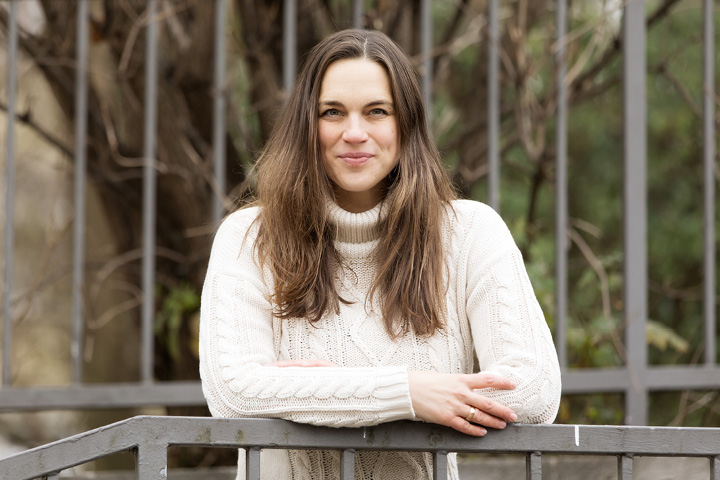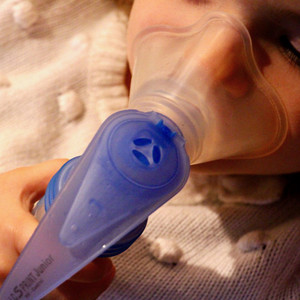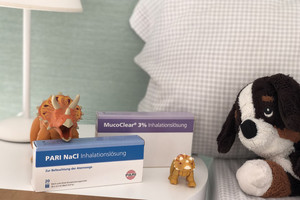The first sign of a cold is usually a stuffy nose, and that sets off the alarm bells in parents. It’s no different in the Warth family. In this interview, Petra Warth, mother of three, explains how she manages infections in her children in winter and the role that nebulisation plays.

Petra Warth: When colds are doing the rounds, definitely every child is ill or run down every four to six weeks, even it if just a snotty nose. When the weather turned wet and cold this year, it hit all three children. They all had terrible runny noses. They just didn’t stop running.

Petra Warth: As soon as one child has sniffles or a bit of a cough, we start with the inhalation.
Petra Warth: Yes, that’s right. As soon as one of them gets a runny nose, we get the nebuliser out. I have the impression that that often wards off a more serious illness. The runny nose usually doesn’t turn into a proper cold. The children use a mask with the nebuliser, by the way, even though I know that inhalation with the mouthpiece is recommended for older children. I find the mask lends itself to inhalation when you have a runny nose in particular because the mask also covers the nose. The children can breathe in through their noses every now and then. That moistens the nasal linings and the mucus there can be loosened better.
Petra Warth: If all three children are ill, they take turns using the nebuliser. The children sit on the sofa, are allowed to watch a kids’ show and the PARI BOY is passed from child to child. Every child uses it for about 10 minutes and every child has their own nebuliser. Usually, the children inhale a 0.9% saline solution. If there is a lot of mucus, the older children inhale a mixture of the 0.9% solution and a 3% saline solution.
Petra Warth: Especially when they have a hacking cough, the mucus is loosened more easily with the inhalation. The cough becomes productive and the children can more easily cough up the phlegm. It may be that the children sometimes cough more after inhalation, but that soon calms down. Generally speaking, I can see in all three children that it does them good and the cough improves.
Petra Warth: For instance, our youngest son had a cough a few weeks ago. I let it run its course for two days. The cough was getting worse and worse, so we started using the nebuliser. After two days of inhalation, the cough improved. Of course, you don’t know what it would have been like without the inhalation, but in most cases there is an improvement if you use the nebuliser. It is the same in my middle son. When he was little, he had quite a few bouts of viral croup and bronchitis. We used the nebuliser on him too. You could see that the inhalation helped ease his cough, too. When our daughter was little, she went through a phase where she had a cold she just couldn’t shift. We went on holiday by the seaside. After a few days of sea air, the cough was gone. Nebulisation with saline solution is basically no different from breathing in sea air. Based on this experience, our children regularly use the nebuliser when they have a cold or a runny or stuffy nose. Our paediatrician also expressly recommended using the nebuliser for respiratory tract infections.

Petra Warth: As I said, the children inhale saline solution when they have a cold. And we always use the PARI BOY. With children, it is dangerous to inhale steam over a bowl filled with hot water. Besides, the salt doesn’t reach the lungs through the steam. If the cough is really bad or the children have a fever or problems like breathlessness, we do of course go to our paediatrician. So far, he has advised us to use a high percentage saline solution, regardless of the diagnosis or has also prescribed drugs that dilate the airways. You can only inhale medications using a nebuliser. Our doctor also prescribed the PARI BOY, as our children used to be quite prone to respiratory tract infections. Our health insurance covered most of the costs. I recommend all parents whose children are prone to respiratory tract infections to get their own nebuliser. You need it frequently and especially spontaneously. It is a bother and costs valuable time hiring a device from the pharmacy each time. Besides, you can only stop a cold in its tracks early on with inhalation if you have your own machine.
Petra: The PARI BOY is definitely durable and a high-quality product. We bought our first PARI BOY six-and-a-half years ago for our oldest daughter’s cough. The device works just as well today as on the first day although it has gotten a ton of use every cold season for six-and-a-half years. From a hygienic perspective, I think it is good that the nebulisers can be boiled in a pot or can be disinfected in a steam steriliser. This way I can prevent viruses from attaching to the nebuliser or bacteria from growing in it that my children would then inhale the next time they use it. After all, that would be dangerous. So having the option of hygienic processing is very important to me. When I had questions about hygiene or the device the pharmacy was always able to help me. But I think that only happened once. The PARI BOY has worked for years problem-free.
Petra Warth: If children are under one year old, it can be difficult at first. The device is loud and they aren’t familiar with it. My youngest used to cry at the beginning. To introduce him to inhalation, I explained the device to him, showed him on myself how to inhale and put him on my lap for the inhalation. He also saw his brother and sister using the nebuliser. With a little distraction, he eventually used the nebuliser without any problems. Our paediatrician said that if it really didn’t work, you should let the child inhale using the inhalation mask while they are asleep. That worked for us too, even though the device is loud.
Petra Warth: There isn’t much you can do to fight a viral infection. I make sure the children have plenty to drink and sometimes rub on a medicated ointment. For the youngest, I hang up a bag of chopped up onion and give him baths with special essential oils to help with colds. There isn’t much more you can do. With the nebuliser, I am counting on the fact that the mucosal linings are moistened and that makes them less susceptible to viruses. And, of course, on the fact that any mucus is loosened.
On her blog "allesinklein" Petra has been writing about day-to-day life as a mother since the birth of her first child in 2012 and she also shares her experience on Instagram (allesinklein). As well as all kinds of practical tips for beautiful things in life and a penchant for going out (of course, ideally with her brood), she is particularly fond of stories that redefine life every day. And part of being a mum is therefore also dealing with illnesses and ailments.
We came across Petra’s blog by chance. We only recently discovered one of her blog posts from 2016 called: Our little cottage hospital and many thanks to the wonderful PARI BOY. We return our thanks – for the kind praise!
Notes: Photos provided by Petra Warth and Marion Hogl.
The statements made in the interview are the individual views of the interviewee. They do not necessarily reflect the PARI view or the general state of science.
An article written by the PARI BLOG editorial team.
© 2025 PARI GmbH Spezialisten für effektive Inhalation